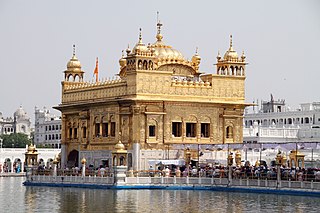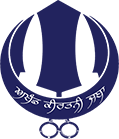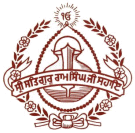
Sikhism, also known as Sikhi, is an Indian religion and philosophy in particular for the Sikh ethnoreligious group that originated in the Punjab region of India around the end of the 15th century CE. The Sikh scriptures are written in the Gurumukhi script particular to Sikhs. It is one of the most recently founded major religious groups and among the largest in the world, with about 25–30 million adherents.

Khalsa refers to both a community that considers Sikhism as its faith, as well as a special group of initiated Sikhs. The Khalsa tradition was initiated in 1699 by the Tenth Guru of Sikhism, Guru Gobind Singh. Its formation was a key event in the history of Sikhism. The founding of Khalsa is celebrated by Sikhs during the festival of Vaisakhi.

In Sikhism, the Five Ks are five items that Guru Gobind Singh, in 1699, commanded Khalsa Sikhs to wear at all times. They are: kesh, kangha, kara, kachera, and kirpan.
Adherents of Sikhism follow a number of prohibitions. As with any followers of any faith or group, adherence varies by each individual.

Kaur, sometimes spelled as Kour, is a surname or a part of a personal name primarily used by the Sikh and some Hindu women of the Punjab region. It is also sometimes translated as 'lioness', not because this meaning is etymologically derived from the name, but as a parallel to the Sikh male name Singh, which means 'lion'.

The Nihang or Akali, also known as Dal Khalsa, is an armed Sikh warrior order originating in the Indian subcontinent. Nihangs are believed to have originated either from Fateh Singh and the attire he wore or from the "Akal Sena" started by Guru Hargobind. Early Sikh military history was dominated by the Nihang, known for their victories where they were heavily outnumbered. Traditionally known for their bravery and ruthlessness in the battlefield, the Nihang once formed the irregular guerrilla squads of the armed forces of the Sikh Empire, the Sikh Khalsa Army.
Sikhs have a given name and one or both of a surname and a Khalsa name. The surname may be a family name or a caste name. Different castes still exist today in some aspects of Punjabi culture; similarly to the Hindu caste system, this system is based on employment.

The Akhand Kirtani Jatha, alternatively romanized as the Akhand Keertanee Jathaa and abbreviated as AKJ, is a jatha and sect of Sikhism dedicated to the Sikh lifestyle. The Jatha follows a strict discipline in keeping the Rehat of Guru Gobind Singh. They also enjoy an active style of Keertan recited by Sikhs in a collective manner in front of Guru Granth Sahib. This style of Keertan is relatively simple, and the entire congregation devotionally participates in singing along.

The Namdharis, also known as Kuka and Kukaism, are a Sikh sect that differs from mainstream Sikhs chiefly in that it believes that the lineage of Sikh Gurus did not end with Guru Gobind Singh (1666–1708), as they recognize Balak Singh (1797–1862) as the 11th Guru of the Sikh religion, thus continuing the succession of Sikh Gurus through the centuries from Guru Nanak Dev to the present day. The 12th Guru was Ram Singh (1816–1885), who moved the sects centre to Bhaini Sahib (Ludhiana) and is regarded as the first Indian to use non-cooperation and non-violence boycott in order to combat the British Empire in India.

Panj Pyare refers to a gathered ad hoc quintet of five baptized (Amritdhari) Khalsa Sikhs who act as institutionalized leaders for the wider Sikh community.

A dastār is an item of headwear associated with Sikhism and Sikh culture. The word is loaned from Persian through Punjabi. In Persian, the word dastār can refer to any kind of turban and replaced the original word for turban, dolband (دلبند), from which the English word is derived.
The principles of Sikhism state that women have the same souls as men and thus possess an equal right to cultivate their spirituality with equal chances of achieving salvation. Women in Sikhism participate in all religious, cultural, social, and secular activities including lead religious congregations, take part in the Akhand Path, perform Kirtan, perform Gatka and work as a Granthis.

A kara is a steel or cast iron bangle worn by Sikhs. It is not necessarily expected to be worn by all Sikhs, but it is a prevalent practice and broadly represents ones' devotion to Sikhism. Sikhism preaches the importance of equality, and having reverence for god (Waheguru) at all times, represented through the five Ks; ceremonial items worn or used by Sikhs in the practice of Sikhism, of which kara is one.

Mai Bhago also known as Mata Bhag Kaur, was a Sikh woman who led Sikh soldiers against the Mughals in 1705. She was an exceptionally skilled warrior on the battlefield and is revered as a warrior saint in Sikhism. She was known for rallying the 40 Sikhs who abandoned Guru Gobind Singh at the siege of Anandpur Sahib and bringing them back to fight.
The Sikhs are adherents to Sikhism, the fifth largest organized religion in the world, with around 25 million adherents. Sikh History is around 500 years and in that time the Sikhs have developed unique expressions of art and culture which are influenced by their faith and synthesize traditions from many other cultures depending on the locality of the adherents of the religion. Sikhism is the only religion that originated in the Punjab region with all other religions coming from outside Punjab. All the Sikh gurus, many saints, and many of the martyrs in Sikh history were from Punjab and from the Punjabi people. Punjabi culture and Sikhism are mistakenly considered inseparably intertwined. "Sikh" properly refers to adherents of Sikhism as a religion, strictly not an ethnic group. However, because Sikhism has seldom sought converts, most Sikhs share strong ethno-religious ties, therefore it is a common stereotype that all Sikhs share the same ethnicity. Many countries, such as the U.K., therefore misconcievingly recognize Sikh as a designated ethnicity on their censuses. The American non-profit organization United Sikhs has fought to have Sikhs included on the U.S. census as well, arguing that Sikhs "self-identify as an 'ethnic minority'" and believe "that they are more than just a religion".

The Battle of Sri Muktsar Sahib(Muktsar) or Battle of Khidrāne Dee Dhāb took place on 29 December 1705, (29 Poh) following the siege of Anandpur Sahib. In 1704, Anandpur Sahib was under an extended siege by the allied forces of the Mughals and the Hill States of Shivalik.

Sikh sects, denominations, traditions, movements, sub-traditions, also known as sampardai in the Punjabi language, are sub-traditions within Sikhism that believe in different approaches to practicing the religion. All sampradas believe in the One Creator God typically rejecting both idol worship and caste systems. Different interpretations have emerged over time, some of which have a living teacher as the leader. The major historic traditions in Sikhism, states Harjot Oberoi, have included Udasi, Nirmala, Nanakpanthi, Khalsa, Sahajdhari, Namdhari Kuka, Nirankari and Sarvaria.

Rama, known as Ram Avatar or Raja Ram, is considered an important figure in Sikhism, due to his inclusion as one among the 24 incarnations of Vishnu in the Chaubis Avtar, a composition in the Dasam Granth traditionally and historically attributed to Guru Gobind Singh. The discussion of Rama and Krishna is the most extensive in this section of the secondary Sikh scripture. The composition is martial, stating that the avatar of Vishnu appears in the world to restore good and defeat evil, but asserts that these avatars are not God, but agents of the God. God is beyond birth and death. The famous Savaiya and Dohra from the Rehras Sahib, read daily be devout Sikhs, comes from Ram Avtar Bani. However, it is not to be confused with Sikhs believing or worshipping Raja Ram or Krishan. It is clear from Guru Gobind Singh's verses in Chaupai Sahib, a part of Sikh Nitnem, or daily prayer.
Nikky-Guninder Kaur Singh, also known as Nikky Singh, is an Indian-born American scholar in Sikhism, and professor and chair of the Department of Religious Studies at Colby College in Waterville, Maine, USA.

















